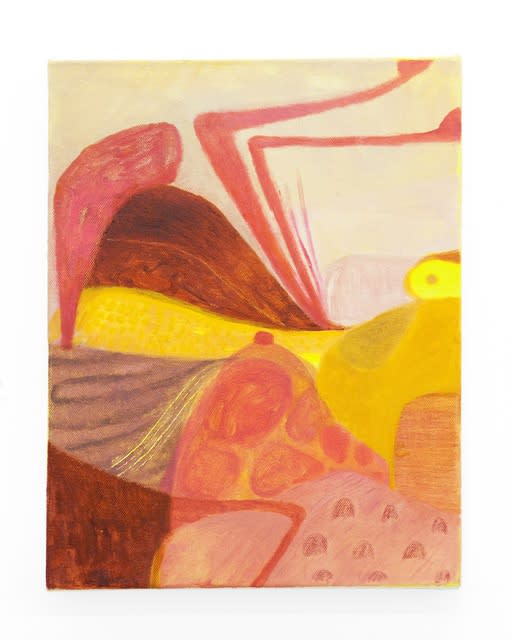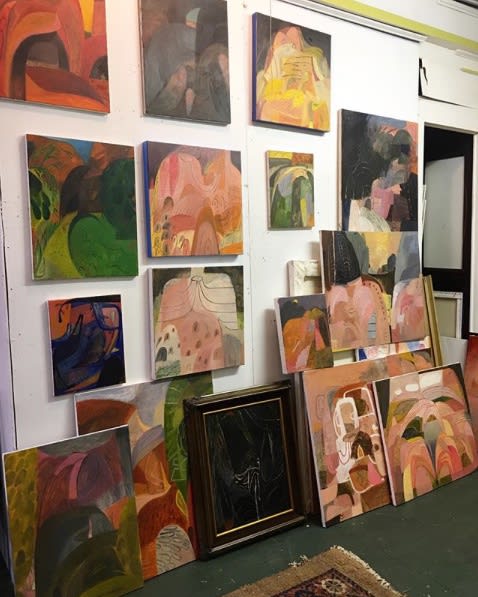SOUMYA NETRABILE
@NETRABILE
Netrabile was born in India, and moved to the USA when she was 7 years old. She is currently based in Chicago. Netrabile’s work are these stunning, strange amalgamations of structured, unknown yet strangely familiar entities or landscapes. Fleshy and earthy. They explore intimacy and relationships, juxtaposing anatomy and natural world with constructions and mechanisms.
Her abstract paintings leave me wondering, gazing and wanting more. They are fantastic and raw, helped by the combination of media; charcoal, watercolour, frontage, collage and pastel.
-
INTERVIEW
Soumya, thank you so much for talking to me during this time! The first question I want to ask you is about how your work is perceived. What do you want your work to say?
This is a question I cannot easily answer. I don’t really have any overarching agenda. My focus tends to stay fixed on small revelations that occur through the process and how I can use them to help me gain bits of wisdom to feedback into the craft. I also have two or three trajectories going at any given time. So deliberating on what I want the work to say is not as important to me as finding connections between the pieces and the trajectories. I remind myself constantly that this is a long term non-linear process. There might be something from a piece I worked on years ago that surfaces in a piece I’m working on now. It’s best for me to stay in a state of flux where I question everything—my relationship to the works, the state of the medium, notions of certainty and progress. It’s the adventure of walking into the unknown that I’m addicted to. Most everything I love deeply comes from a place of curiosity, uncertainty, mystery, and humour, so I hope those qualities come through the work. I hope a viewer is able to respond and connect to the feelings the work evokes.
Is colour important to your work? Is the relationship between colour the most vital thing? Tell us about your colour palette.
I try to push myself to find interesting color relationships, but usually end up following an urge or instinct. With the anatomical images, it somehow just feels right to use the pinks or flesh tones. I use pinks straight from a tube (I’ve bought pretty much every shade that exists in the store), though sometimes I blend my own. I’ve tried breaking from them, using greens or other colors, but then the final images never seem right and I end up destroying them and starting over with pinks. I’ve come to personally regard the pinks and flesh tones as totemic. They obviously represent flesh, but also for me, terrains of the earth. Through these pinks, I can connect the body to the earth.
In my most recent paintings exploring organic plant forms, I have been playing more with loud contrasts and unusual harmonies. It’s always tricky because I don’t like to force anything when I paint. There’s always that fine balance of negotiating urge against control. I really do try hard to stay in a place where I am feeling my way through the work and it’s no different with color.
Do you have any advice for an aspiring artist?
I can only say what I wish someone had said to me when I started out. It’s really important to trust yourself. Most often your own mind and your preconceptions of what you think you should or shouldn’t be doing are your worst enemies. You have to stay focused and train yourself to pay only slight attention to such voices as well as any rewards that come your way. You have to stay the course and not let distractions stop you from helping the work go where it needs to go. And the work doesn’t always move forward. It might move backward at times and then forward again. You’ve got to trust the journey.
-
"It's really important to trust yourself."
Who is your favourite female artist working at the moment?
There are so many whose work has moved me that it’s impossible to pick a favorite. I admire work that is very ambitious and heroic like the work of Kara Walker, Simone Leigh, and Julie Mehertu. Erin Lawlor’s way of mutating color and light always puts me in awe. You can get sublimely lost in her paintings. And Henni Alftan’s intimate paintings are like sweet haikus. I could meditate on those forever.
There are so many others.
Where do you get your inspiration?
I start with a color and try to keep my interest focused on how can I play with the paint. I like experimenting with mediums, brushes, thicknesses, fluidity. Most of the time the paint and the cooperation or resistance of the surface guides my hand and my decisions. This being said, the body, whole and in its parts and configurations, is a usual starting point. This makes sense to me because it is what I know best—my limbs, my appetites, my senses, how I’m able to move or bend. In the kind of meditation I practice, I work on connecting to the parts inside my body, so I’m very tuned to that interior landscape. The initial forms that emerge usually start changing as I work the paint. Maybe an arm will turn into a flower petal, and it feels right for a moment so I leave it be. The next moment that petal changes into a uterus or an elephant head and so forth. I try hard not to judge whatever flows in and out. Keeping myself and the work in a state of openness is important. In the midst of working through an image, you’re always confronted by moments where you must make decisions. Inspirations are tiny little creatures that are born at such junctures, asking for life or death. But if you’re not working in a state of openness, they’re more likely to stay hidden.
There’s a poem by Gary Snyder that describes this feeling. I dwell on it often and the last line in particular:
It comes blundering over the
Boulders at night, it stays
frightened outside the
Range of my campfire
I go to meet it at the
Edge of the light.




